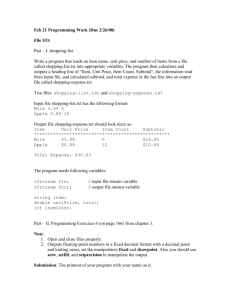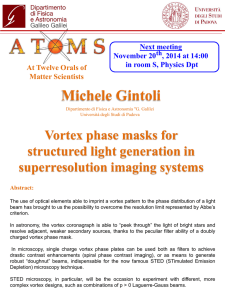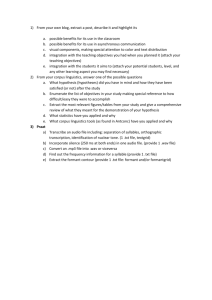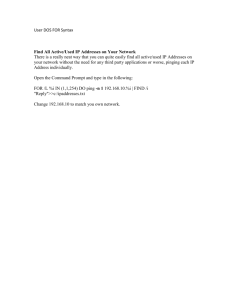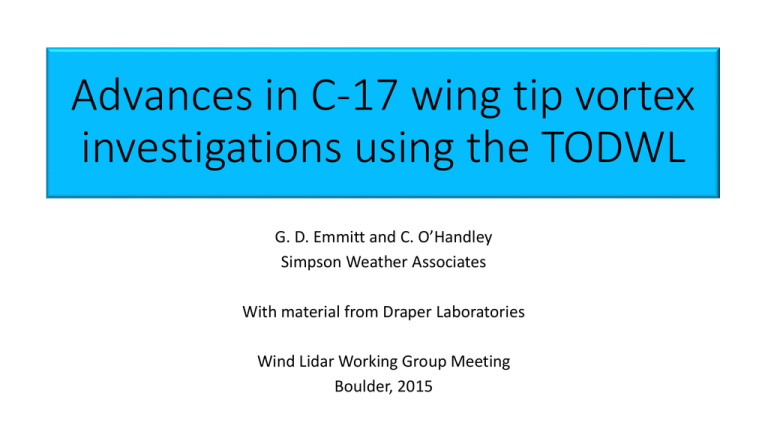
Advances in C-17 wing tip vortex
investigations using the TODWL
G. D. Emmitt and C. O’Handley
Simpson Weather Associates
With material from Draper Laboratories
Wind Lidar Working Group Meeting
Boulder, 2015
Program for Flight Separation Reduction
during air deliveries
• Models are considered too ideal but still being pursued
• Need to express risk to personnel in probabilistic terms
• Most of what is known quantitatively has been obtained via
groundbased DWLs with the exception of some DLR work in 2009.
• This work is funded by the US Army to obtain airborne DWL data to
improve the existing WTV model being developed by Draper
Laboratories and to explore alternatives to current aircraft spacing
criteria.
C-17 General Characteristics
Length: 174 feet (53.04 m)
Height at Tail: 55.1 feet (16.79 m)
Wing Span to Wingtips: 169.8 feet (51.74 m)
Maximum Payload: 164,900 lbs. (74,797 kg)
Range with Payload: 2,420 nautical miles
Cruise Speed: 0.74 – 0.77 Mach
Approach Speed: 130kts
Vortex concepts and photo realizations
As time goes on
Provided by Fred Proctor, NASA/LaRC
Also possible (likely?)
Provided by Fred Proctor NASA/LaRC
WTV Model
WTV model predictions
Lifetime (s)
7.50
15.00
30.00
Distance
Core
Sink Rate Vortex Max vtan Radius(m) where
behind aircraft altitude (m) (m/s) core radius (m/s)
Vtan = 5 m/s
(m)
(m)
0.50
370.73
1.38
0.42
119.21
11.58
1.00
357.93
1.71
0.60
84.45
11.58
2.00
331.71
1.75
0.85
59.45
11.58
60.00
4.00
279.88
1.73
1.20
42.07
11.58
90.00
6.00
237.80
1.40
1.47
23.17
7.75
120.00
8.00
207.93
1.00
1.70
14.94
5.81
150.00
10.00
184.76
0.77
1.90
10.67
4.65
180.00
12.00
166.46
0.61
2.08
8.23
3.82
210.00
14.00
150.61
0.53
2.24
6.40
2.94
240.00
16.00
137.20
0.45
2.40
5.18
0.00
270.00
18.00
125.30
0.40
2.54
4.57
0.00
300.00
20.00
114.94
0.35
2.68
3.66
0.00
W= 400,000 lb, V = 130 knots, Altitude = 1250 ft
Copyright 2015 by the Charles Stark Draper Laboratory, Inc. All rights reserved
.
Circulation Calculation
Γ = 2* π * r * V(r)
r = distance from vortex core
V(r) = tangential speed at distance r
TODWL
Twin Otter Doppler Wind Lidar
Particle
probes
TODWL
scanner
STV
CTV
Surface
Temperature
Sensor
Simpson Weather Associates
Owned by Navy’s
Center for Interdisciplinary
Remotely Piloted Aircraft Studies
CTV
Controlled Towed Vehicle
Developed by UC, Irvine
Major considerations
• Differential speed between C-17 and Twin Otter. +-10 kts of 130 kts.
• Scanner slew rate
• Maximum of 30 degrees/second
• What are the maximum tangential velocities expected?
• TODWL’s bandwidth is +- 25 m/s
• What is the area of regard for life cycle monitoring?
• Taking cross track drift into consideration
• Measurements of thermal stability and wind profiles between surface
and 1000m
Twin Otter
1000m AGL
17 degrees
400 m
min range
C-17
Chirp effects
below 50 m
50 m
tip - tip
300 m
Aircraft positions and TODWL area of regard
200m AGL
TODWL Sampling Modes
Mode Name
C - 17
T-Otter
Comments
Backslide
600’
(130K)
3000’
(110K)
Begin sampling with Twin Otter above and just
forward of C -17; drift backwards while nadir raster
scanning
Opposing
600’
(130K)
3000’
(140K)
Begin nadir raster sampling when TO is on
opposing track to that just flown by C-17
Trailing
600’
(130K)
1000’
(130K)
Begin 3km behind C-17 and use dithered
prospecting scan at – 6 degrees for 5 min.
Prospecting
600’
(130K)
1000’
(120K)
Begin 3km lateral to C-17 path and cross over DZ;
do 180 and repeat going other direction.
DZ cross (GB)
600’
(130K)
Zero‘
(Zero)
Park the Twin Otter in a position to allow the lidar
to scan the DZ from a side perspective to C-17
path.
DZ along (GB)
600’
(130K)
Zero‘
(Zero)
Park the Twin Otter in a position 3 -5 km “up
approach” from the DZ to allow the lidar to scan
the DZ along the C-17 path. C-17 would need to fly
a J leg to avoid having vortexes hit the Twin Otter.
Key Issues addressed with TODWL
• Capturing signals from vortices over periods of several minutes using
“opposing” flight paths and “fallback” sampling.
• Identifying region where vertical velocities are > 15 m/s (Danger
Zone)
• Identifying and mapping individual vortices throughout several
minutes of lifetime (location of vortex centers).
• Computing circulation values using lidar samples obtained at vortex
radii ~ 10 – 20 meters.
Vu(left) = 7 m/s
Vd (left) = 10 m/s
1865
1876
1859
1883
R(right) = 3.5*2.5=8.75
R(left) = 3.0*2.5 = 7.5
Sink Rates
Priority Datasets
• 21 Data sets for opposing flights at night (4/22-4/23)
• Most of the datasets have a data available for a vortex age between 60 to 120
seconds
• No major changes in aircraft weight from first pass to last pass on a given
lift
Date
Initial Weight
Final Weight
Notes
4/22 Night
382280
374680
~800m altitude
4/23 Early morning
397080
384680
~500m altitude
4/23 Early morning
380080
369200
~400m altitude
4/23 Night
398800
375600
~800m altitude
• C17 speed relatively constant between passes
• Most in the 130-132 knots range
• 4 outside (143.3, 134.75, 136.5, 134.1)
Copyright 2015 by the Charles Stark Draper Laboratory, Inc. All rights reserved.
All Datasets – Height vs. Vortex Age
Height vs. Time
900
800
wakes_0422_221157_jan09.txt
wakes_0422_222039_jan09.txt
wakes_0422_222645_jan09.txt
wakes_0422_223334_jan09.txt
wakes_0423_003033_dec10.txt
wakes_0423_003805_dec10.txt
wakes_0423_004614_dec10.txt
wakes_0423_005438_dec10.txt
wakes_0423_010539_dec12.txt
wakes_0423_011359_dec12.txt
wakes_0423_012220_dec12.txt
wakes_0423_012932_dec12.txt
wakes_0423_013707_dec12.txt
wakes_0423_210800_jan19.txt
wakes_0423_211504_jan19.txt
wakes_0423_212211_jan19.txt
wakes_0423_213117_jan19.txt
wakes_0423_214105_jan19.txt
wakes_0423_215017_jan19.txt
wakes_0423_220436_jan19.txt
wakes_0423_221125_jan19.txt
700
height (m)
600
500
400
300
200
0
20
40
60
80
100
120
vortex age (sec)
Copyright 2015 by the Charles Stark Draper Laboratory, Inc. All rights reserved.
140
C17 Altitude ~800m
Tests conducted over two different nights
4/22/14 and 4/23/14
12 different flights passes
Copyright 2015 by the Charles Stark Draper Laboratory, Inc.
All rights reserved.
C17 Altitude ~ 800m – Height vs. Vortex Age – Right Vortex
Height vs. Time
850
wakes_0422_221157_jan09.txt
wakes_0422_222039_jan09.txt
wakes_0422_222645_jan09.txt
wakes_0422_223334_jan09.txt
wakes_0423_210800_jan19.txt
wakes_0423_211504_jan19.txt
wakes_0423_212211_jan19.txt
wakes_0423_213117_jan19.txt
wakes_0423_214105_jan19.txt
wakes_0423_215017_jan19.txt
wakes_0423_220436_jan19.txt
wakes_0423_221125_jan19.txt
Linear Fit Slope All = -1.4688
Linear Fit Slope 1 = -1.7106
Linear Fit Slope 2 = -0.87269
800
height (m)
750
700
650
600
550
0
20
40
60
80
100
vortex age (sec)
Copyright 2015 by the Charles Stark Draper Laboratory, Inc. All rights reserved.
120
140
C17 Altitude ~ 800m – Height vs. Vortex Age – Left Vortex
Height vs. Time
850
wakes_0422_221157_jan09.txt
wakes_0422_222039_jan09.txt
wakes_0422_222645_jan09.txt
wakes_0422_223334_jan09.txt
wakes_0423_210800_jan19.txt
wakes_0423_211504_jan19.txt
wakes_0423_212211_jan19.txt
wakes_0423_213117_jan19.txt
wakes_0423_214105_jan19.txt
wakes_0423_215017_jan19.txt
wakes_0423_220436_jan19.txt
wakes_0423_221125_jan19.txt
Linear Fit Slope All = -1.3987
Linear Fit Slope 1 = -1.5193
Linear Fit Slope 2 = -0.70304
800
height (m)
750
700
650
600
550
0
20
40
60
80
100
vortex age (sec)
Copyright 2015 by the Charles Stark Draper Laboratory, Inc. All rights reserved.
120
140
C17 Altitude ~ 800m – Height vs. Vortex Age
• Two descent rates can be seen in the data
• The change in rates occur approximately around 60 seconds
• First 60 second mainly a higher constant descent rate
• 1.71 meters per seconds – right vortex
• 1.52 meters per seconds – left vortex
• After 60 seconds a slower descent rate
• More variation
• 0.87 meters per seconds – right vortex
• 0.70 meters per seconds – left vortex
Copyright 2015 by the Charles Stark Draper Laboratory, Inc. All rights reserved.
C17 Altitude ~500m
Tests conducted over one early morning
4/23/14
4 different flights passes
Copyright 2015 by the Charles Stark Draper Laboratory, Inc.
All rights reserved.
C17 Altitude ~ 500m – Height vs. Vortex Age – Right Vortex
Height vs. Time
550
wakes_0423_003033_dec10.txt
wakes_0423_003805_dec10.txt
wakes_0423_004614_dec10.txt
wakes_0423_005438_dec10.txt
Linear Fit Slope All = -1.4028
Linear Fit Slope 1 = -1.6029
Linear Fit Slope 2 = -1.4541
500
height (m)
450
400
350
300
250
0
20
40
60
vortex age (sec)
80
100
Copyright 2015 by the Charles Stark Draper Laboratory, Inc. All rights reserved.
120
C17 Altitude ~ 500m – Height vs. Vortex Age – Left Vortex
Height vs. Time
550
wakes_0423_003033_dec10.txt
wakes_0423_003805_dec10.txt
wakes_0423_004614_dec10.txt
wakes_0423_005438_dec10.txt
Linear Fit Slope All = -1.1924
Linear Fit Slope 1 = -1.4888
Linear Fit Slope 2 = -0.70282
500
height (m)
450
400
350
300
250
0
20
40
60
vortex age (sec)
80
100
Copyright 2015 by the Charles Stark Draper Laboratory, Inc. All rights reserved.
120
C17 Altitude ~ 500m – Height vs. Vortex Age
• Two descent rates can be seen in the data
• The change in rates occur approximately around 60 seconds
• First 60 second mainly a higher constant descent rate
• 1.60 meters per seconds – right vortex
• 1.49 meters per seconds – left vortex
• After 60 seconds a slower descent rate
• More variation
• 1.45 meters per seconds – right vortex
• 0.70 meters per seconds – left vortex
Copyright 2015 by the Charles Stark Draper Laboratory, Inc. All rights reserved.
C17 Altitude ~400m
Tests conducted over one early morning
4/23/14
5 different flights passes
Copyright 2015 by the Charles Stark Draper Laboratory, Inc.
All rights reserved.
C17 Altitude ~ 400m – Height vs. Vortex Age – Right Vortex
Height vs. Time
440
wakes_0423_010539_dec12.txt
wakes_0423_011359_dec12.txt
wakes_0423_012220_dec12.txt
wakes_0423_012932_dec12.txt
wakes_0423_013707_dec12.txt
Linear Fit Slope = -1.9258
420
400
380
height (m)
360
340
320
300
280
260
240
0
10
20
30
40
vortex age (sec)
50
60
Copyright 2015 by the Charles Stark Draper Laboratory, Inc. All rights reserved.
70
80
C17 Altitude ~ 400m – Height vs. Vortex Age - Left Vortex
Height vs. Time
440
wakes_0423_010539_dec12.txt
wakes_0423_011359_dec12.txt
wakes_0423_012220_dec12.txt
wakes_0423_012932_dec12.txt
wakes_0423_013707_dec12.txt
Linear Fit Slope = -1.5686
420
400
380
height (m)
360
340
320
300
280
260
240
0
10
20
30
40
vortex age (sec)
50
60
Copyright 2015 by the Charles Stark Draper Laboratory, Inc. All rights reserved.
70
80
C17 Altitude ~ 400m – Height vs. Vortex Age
• Smaller time of data available – around 75 seconds
• Relatively constant descent rate
• 1.93 meters per seconds – right vortex
• 1.57 meters per seconds – left vortex
• We can start to see the change in the descent rate around 60
seconds
Copyright 2015 by the Charles Stark Draper Laboratory, Inc. All rights reserved.
Summary of All the Data
Vortex Descent Rates (m/s)
Altitude
(m)
Mean Velocity Decay (m/s^2)
First 60 Sec
After 60 Sec
Ascending
Descending
Right
Left
Right
Left
Right
Left
Right
Left
Right
Left
800
1.71
1.52
0.87
0.70
0.022
0.017
0.016
0.018
0.019
0.018
500
1.60
1.49
1.45
0.70
0.032
0.028
0.027
0.015
0.030
0.022
400
1.93
1.57
-
-
0.048
0.053
0.014
0.026
0.031
0.039
Working on calculating standard deviation for the decent and decays rates
Copyright 2015 by the Charles Stark Draper Laboratory, Inc. All rights reserved.
Both Cores
Progress on computing circulation
Circulation calculations
• The maximum tangential velocities may be ~ 100 m/s per various
WTV models
• Since TODWL has a +- 25m/s receiver bandwidth and a ~80m
Gaussian pulse length, we compute the circulation at radii where the
tangential velocities are less than 10 -20 m/s.
• Using techniques developed in part by the DLR during similar
airborne DWL investigations in 2009.
• SWA has expanded (and continues to do so) on the “spectral envelop”
approach during this FSR project.
SWA Method*
The method is as follows:
• Identify center of vortex (shot, gate)
• Using envelope velocities, calculate circulation moving outward from
vortex center at each shot (average separation about 2 m but varies with
scan angle)
• Circulation is estimated by examining a region within 10 gates of the core
location.
• Tabulate the strongest envelope velocity and the average envelope velocity
within that region, and then calculate a circulation from each, so two
estimates per shot (distance)
* Base in part on work done by DLR
First 10 seconds of WTV lifetime
Radius sensitivity
• The computations are very sensitive. For example, if we've picked the
wrong shot for the vortex center, everything shifts by an average of
2m.
• If you have a Vlos estimate of 6 m/s at 10 m, that's 377 m2/s. If you
shift that 2 m you have a potential circulation range of 302 – 452
m2/s. That could possibly explain the outliers in the averaged data.
Summary
• Using our latest algorithms, the general estimates of WTV sink rates,
vortex separation distances, drift angles and circulation values appear
to pass the “reasonable” test when compared with the WTV model
data from Draper. But…..
• There are occasions, however, where the sink rates differ between
lifts conducted within the same (?) environment.
• There are cases where the separation between vortices is > 50m,
somewhat counter to the expectation that vortices interact
destructively and “pinch” together.
• There are cases where the sink rate for one vortex in a pair is
consistently different that the other’s sink rate.
Summary of SWA algorithm errors
• Given the sampling limitations of the TODWL system, we expect:
• Uncertainty in locating the centers of each vortex (+- 5 meters horizontal)
• Running average location over 10 sweeps (10 – 20 seconds) seems to be very reasonable
• Uncertainty in height assignment of individual vortex (+- 25 m vertical)
• Running average vertical location over 10 sweeps seems to be very reasonable
• Uncertainty in the estimation of the circulation (+- 30%)
• 10 sweep running average circulation values are also quite reasonable and in agreement with
model predictions
• Therefore, our focus is now shifting to:
• Sink rates outside the envelope of expected values
• Vortex separations that exceed 60m
• Loss of detectable vortices in areas preceded and followed by detectable vortices.
Recommendations for next flight series
• Fly the C-17 well above the boundary layer to reduce convective
interference with vortices. This will improve model validation for the
basic physics of WTV generation and evolution.
• Fly within stable or neutral boundary layers. Marine boundary layers
over the coast of California offer a good laboratory.
• Fly longer legs with the C-17 (3-5 minutes instead of 2).
Acknowledgements
• USArmy funding through Phase II SBIR to SWA
• Draper Laboratories for conducting model/data comparisons
• Kevin Godwin of KGS, LLC for assistance in operating TODWL in the
Yuma field experiments and generating realtime/quicklook TODWL
soundings used in planning the next day experiments.

